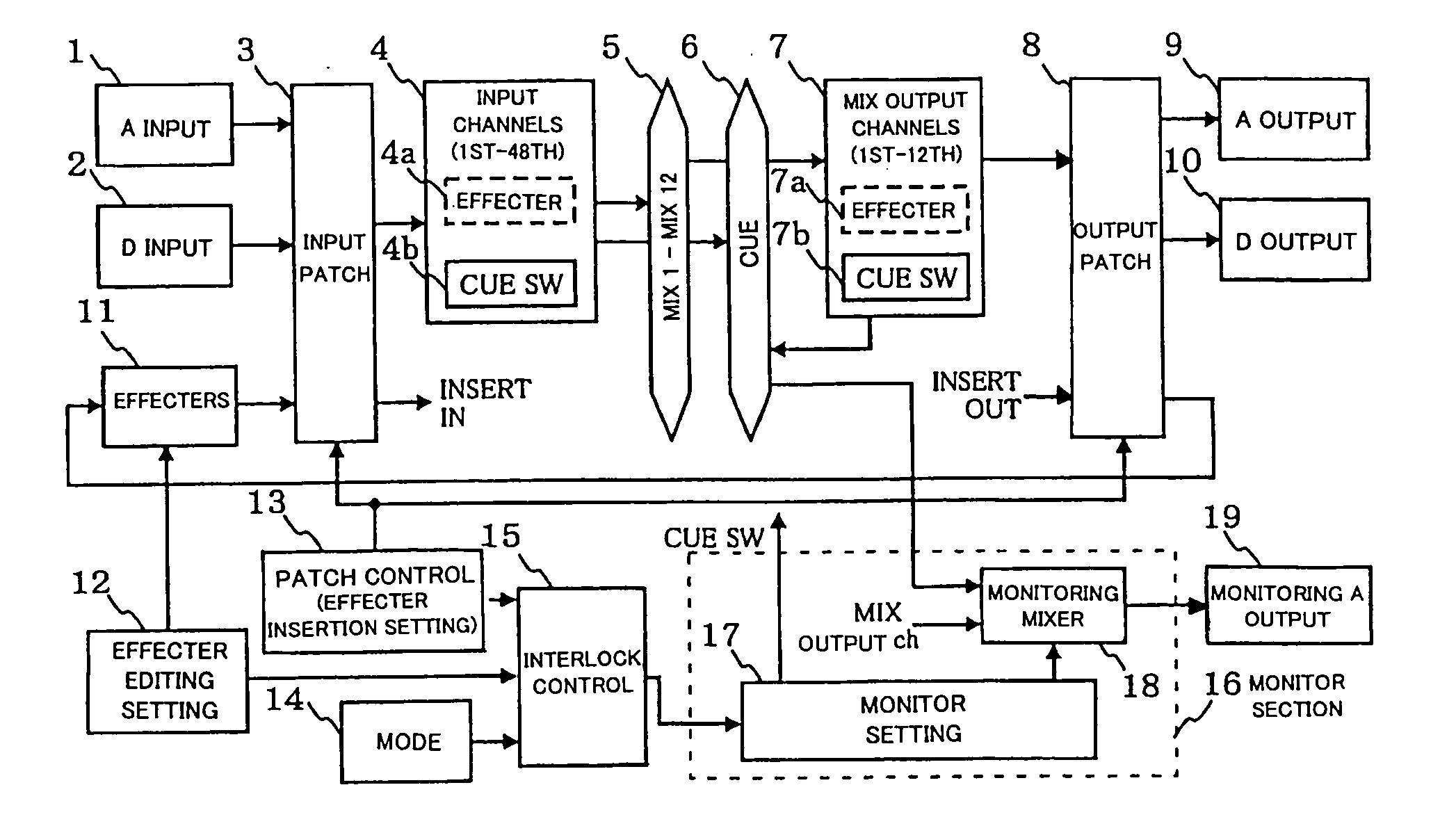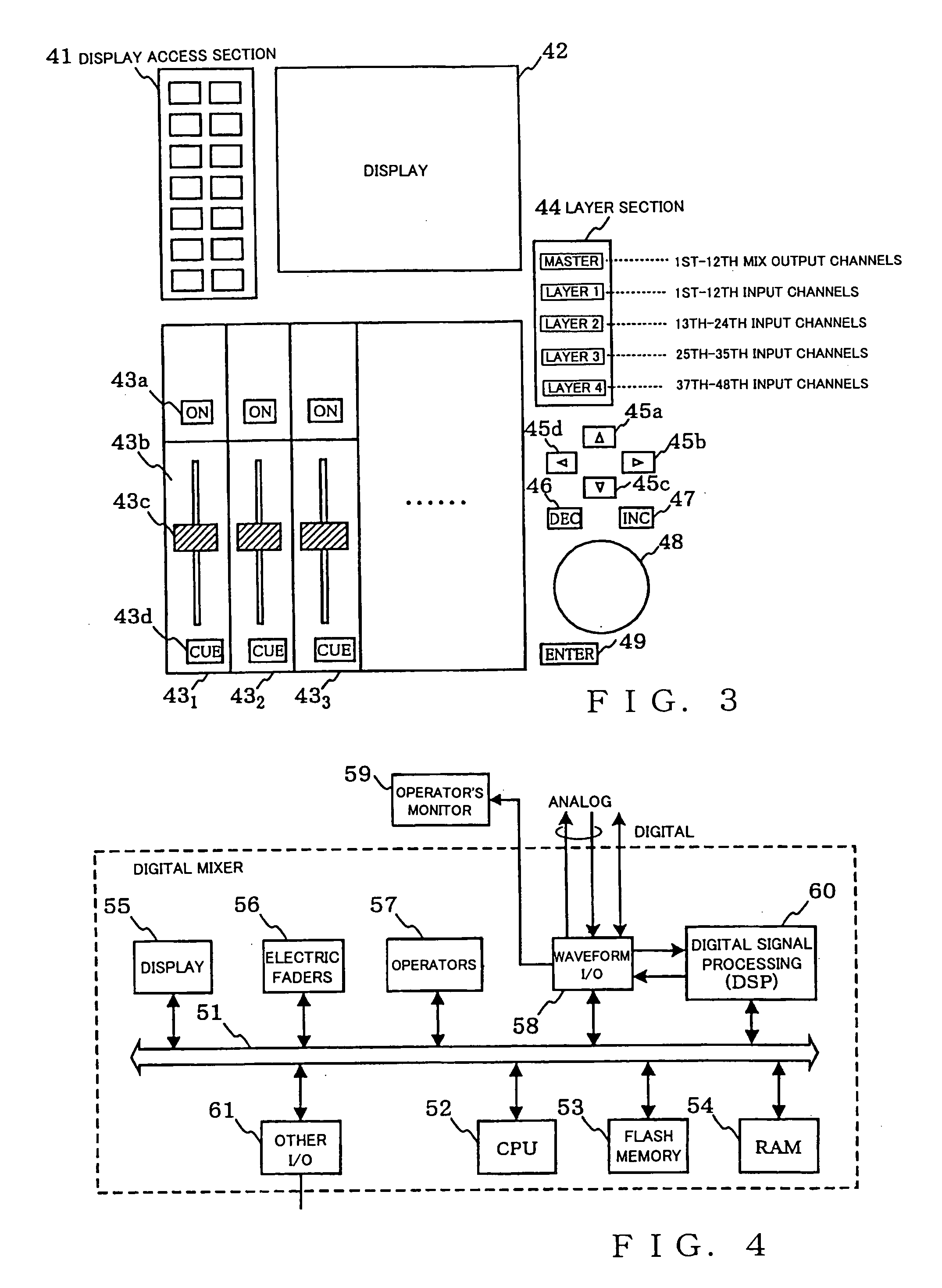[0007] According to the present invention, the digital mixer apparatus has the function for, irrespective of whether the apparatus is set in the
interlock mode or in the non-
interlock mode, monitoring (cuing or CUE-monitoring) a desired one of the input channels in response to object-of-monitoring selecting operating by a human operator as in the conventional digital mixer apparatus. In addition to such a conventional function, the digital mixer apparatus of the present invention has the function that, while the apparatus is set in the interlock mode and only if one of the plurality of effecters is selected as an object of editing, permits automatic monitoring (CUE-monitoring) of an input channel having the selected effecter inserted therein. Namely, with no particular object-of-monitoring selecting operation performed, the signal of the input channel can be automatically output for the monitoring purpose. Therefore, the present invention can significantly simplify the operation necessary for automatically monitoring the signal having passed through the selected effecter. Even when a setting has been made such that a signal of the input channel before passing through the effecter is output for the monitoring purpose, operation for changing the setting such that a signal having passed through the effecter is output for the monitoring purpose can be performed with utmost ease. Further, while the digital mixer apparatus is set in the non-interlock mode, the state of the CUE-monitoring does not change in response to selection of an effecter as an object of editing, as in the conventional digital mixer apparatus: consequently, the digital mixer apparatus of the invention can be handled or used with a same feeling as the conventional digital mixer apparatus.
[0008] Therefore, the present invention achieves the benefits that, by the digital mixer apparatus being only set to the interlock mode, the signal of the input channel having the selected effecter inserted therein can be automatically monitored in an interlocked relation with the object-of-editing selecting operation and that signals of one or more channels can be automatically monitored in response to object-of-monitoring selecting operation by the human operator as in the conventional digital mixer apparatus. By being just set to the non-interlink mode, the apparatus can be used with a same feeling as the conventional digital mixer apparatus.
[0009] According to another aspect of the present invention, there is provided a digital mixer apparatus including a plurality of input channels, a plurality of mixing buses and a plurality of output channels corresponding to the mixing buses, the digital mixer apparatus mixing, via the mixing buses, signals processed in the individual input channels and outputting the mixed signals via the output channels corresponding to the mixing buses, which comprises: a monitor section that outputs, for a monitoring purpose, the signals of one or more channels selected, in response to monitoring selecting operation, from among of the plurality of input channels and the plurality of output channels; a plurality of effecters; an effecter
insertion setting section that, for each of the plurality of effecters, performs setting to insert the effecter in a channel designated, in response to
insertion designating operation, from among the plurality of input channels and the plurality of output channels, to allow the inserted effecter to be used in the designated channel; an editing section that edits an effecter selected, in response to object-of-editing selecting operation, from among the plurality of effecters while causing an editing screen for the selected effecter to be displayed on a display; a mode setting section that sets either an interlock mode or a non-interlock mode; and an interlock control section that, when any one of the effecters has been selected via the editing section in response to the object-of-editing selecting operation while the digital mixer apparatus is set in the interlock mode, controls the monitor section to automatically output, for the monitoring purpose, the signal of the channel having the selected effecter inserted therein. Thus, even when the selected effecter is inserted in any one of the output channels, the present invention can achieve the same benefits as discussed above.
[0010] As an example, the
insertion designating operation via the effecter insertion setting section can also instruct, for a given one of the effecters, that the given effecter should not be inserted in any one of the input channels. Even when one of the effecters has been selected via the editing section while the digital mixer apparatus is set in the interlock mode, the interlock control section does not perform automatic output control on the monitor section if the selected effecter is not inserted in any one of the input channels. Thus, even in the interlock mode, the monitoring (CUE-monitoring) state can be prevented from changing, despite the selection of the effecter, if the selected effecter has not been inserted in any one of the input and output channels.
[0011] As an example, the functional ON / OFF state of each of the effecters can be controlled by a human operator. While the digital mixer apparatus is set in the interlock mode, the interlock control section controls the monitor section to automatically output, for the monitoring purpose, the signal of the input channel having the selected effecter inserted therein, irrespective of whether the function of the effecter selected via the editing section in response to the object-of-editing selecting operation is ON or OFF. With such arrangements, it is possible to readily ascertain how the signal changes due to the insertion of the effecter selected in response to the object-of-editing selecting operation, which greatly facilitates editing of the effecter.
 Login to View More
Login to View More  Login to View More
Login to View More 


